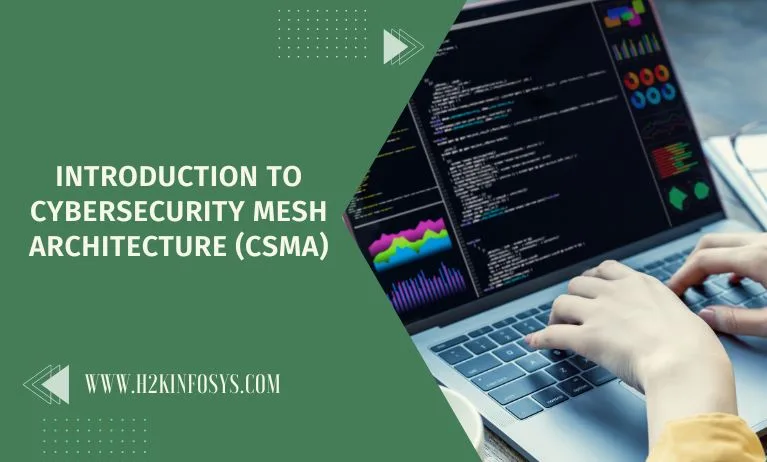Security silos are one of the most difficult Cybersecurity challenges that organizations confront. Many businesses use a variety of point security solutions to handle specific security issues. As a result, security infrastructures become complex and difficult to administer, resulting in missed detections and delayed responses.
CSMA was developed to assist businesses in transitioning from compartmentalized security to a more collaborative and flexible approach to security. By modularizing security functions and allowing them to interoperate through a set of supportive layers, CSMA is intended to make security more composable and scalable. CSMA enables an organization to accomplish greater security with fewer resources by making security more coherent and collaborative. Check out the Cybersecurity online courses to learn more about CSMA.
This security approach is particularly suited to the transition to hybrid, multi-cloud systems, where organizations may need to deliver consistent security across different, developing, and expanding IT environments. CSMA allows a more collaborative, flexible, and scalable approach to managing evolving security needs by creating a framework in which disparate security solutions can collaborate toward common goals.
What Is the Definition of CSMA Foundational Layers?
CSMA is intended to provide a scalable, interoperable, and composable framework for multiple security controls and solutions to more effectively interoperate. The foundational layers of CSMA describe core security goals and functions that different security solutions can work together to achieve.
CSMA characterizes four foundational layers, including:
- Security Analytics and Intelligence: This layer’s solutions concentrate on gathering, consolidating, and analyzing security data from various security technologies. Security information and event management (SIEM) and security orchestration automation and response (SOAR) software may analyze potential threats and activate suitable threat responses based on this data.
- Distributed Identity Fabric: This layer focuses on identity and access management services, which are critical components of a zero-trust security strategy. Decentralized identity management, directory services, identity proofing, entitlement management, and adaptive access are all capabilities.
- Consolidated Policy and Posture Management: Managing and enforcing consistent security rules across several settings necessitates policy translation for each environment. At this level, solutions turn policies into the rules and configuration settings required for a specific environment or tool, or they can provide dynamic runtime authorization services.
- Consolidated Dashboards: By forcing context switches between several dashboards, an assortment of distinct and independent security solutions impedes security operations. This layer gives integrated insight into an organization’s whole security architecture, allowing for more efficient security incident detection, investigation, and response.
Main Benefits Of CSMA
CSMA defines foundational layers that enable security solutions to work more effectively together. This provides the organization with a number of security benefits, including:
- Intelligent Security Design: CMSA defines foundational layers around core security capabilities in its Intelligent Security Design. This enables a company to create a security architecture and deploy solutions based on these fundamentals.
- Consistent Security: By creating an architecture that permits security to be extended as needed, CSMA enables an organization to achieve more consistent security. This helps to ensure that an organization’s developing and expanding infrastructure is consistently protected.
- Flexibility and Scalability: CSMA is intended to add new infrastructure or solutions to an organization’s security architectures as needed. This allows corporate security to keep up with the evolving, distributed IT architecture.
- Improved Collaboration: CSMA is designed to improve collaboration among a company’s multiple security solutions. This speeds up and enhances the effectiveness of threat detection, response, and prevention.
- Simplified Deployment and Management: CSMA establishes a foundation for delivering security solutions, allowing for speedier deployment and configuration of new solutions. Furthermore, the architecture’s flexibility and agility allow it to develop to suit changing business and security needs.
- Improved Efficiency: CSMA combines a company’s security architecture, removing the requirement for security staff to operate and switch between different products. This allows them to deploy, configure, and use solutions more efficiently, freeing up time and resources for other vital security duties.
Major Cybersecurity Mesh Points
Among the important points and objectives of CSMA are:
- Encourage Identity-Centric Security: Zero trust is a security model that focuses on strong user authentication and authorization. CSMA accelerates zero trust adoption by making the move to identity-centric security easier.
- Improve Security Integration: Many businesses have a jumbled mess of different, disconnected security systems. By expanding security collaboration and integration, CSMA hopes to minimize complexity and increase performance.
- Make a Future Plan: Security requirements shift quickly in response to changing IT infrastructure and security threats. CSMA facilitates future expansion by utilizing plug-in APIs to facilitate extensions, customization, analytics, and support for new legislation and standards.
- Improve Solution Interoperability: Organisations frequently face interoperability problems between standalone security systems from different manufacturers. The CSMA aims to bridge these gaps by establishing a framework for collaboration and cooperation.
- Simplify Security Design: CSMA defines supported layers that define long-term, critical security capabilities. This allows businesses to plug in solutions as needed to meet security requirements in an organized manner.
Conclusion
CSMA’s fundamental goal is to simplify security architecture through collaboration and integration of a corporate security architecture. To learn more about CSMA, check out the cyber security online training.































2 Responses